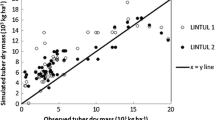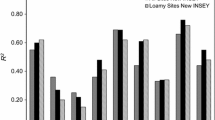Abstract
A linear polynomial model is presented
where Y = plant yield of tubers > 1 cm diameter, X1 = revised growing degree days
X2 = total insolation in cal cm-2 at 350 to 1150 nm and X3 = mean daily air temperature range in °C. The β0 and ξ, (Y intercept and error term) and β1, β2 and β3 coefficients are derived from fitting the experimental data.
The model was developed by growing ‘Kennebec’ in large containers at sites ranging from 1533 m to 3198 m elevation under shaded (48% insolation reduction) and unshaded conditions at 39° to 41° N latitude. Mean maximum and minimum temperatures and insolation ranged from 29°C to 19°C, 14°C to 6°C, and 200 cal cm−2 day−1 to 530 cal cm2 day−1 respectively. Soil matric potential and soil fertility were not included as variables in the model since they were physically controlled. The model does not include the period from planting to emergence since environment was not permitted to vary differentially. A highly significant multiple linear model with a coefficient of determination of 0.93 was obtained.
It is suggested that including the revision
in the heat input estimation (GDD) as well as air temperature range, emphasizes the influence of respiration on productivity. The model should be tested further and adapted as a practical method for predicting potato yield under “grower” conditions.
Resumen
Se présenta un modelo linear polinomial
donde Y = rendimiento de tubérculos > 1 cm de diámetro, X1 = grados días de crecimiento revisado.
X2 = insolación total en cal cm−2 a 350 a 1150 nm y X3 = promedio diario de rango de temperatura del aire en °C. Los términos β0 y ξ (intercepción de Y y el término de error) y los coeficientes β1, β2, y β3 son derivados después de ajustar los datos expérimentales.
El modelo se desarrolló cultivando “Kennebec” en depósitos grandes en un rango de lugares desde 1533 m hasta 3198 m de elevación bajo sombra (48% de reducción de insolación) y sin sombra a 39–41° de latitud Norte. El promedio máximo y mínimo de temperatura e insolación varió desde 29°C a 19°C, 14°C a 6°C, y 200 cal cm−2 día−1 a 530 cal cm−2 día{−1}, respectivamente.
El potencial de la matriz del suelo y la fertilidad del suelo no fueron incluídos como variables en el modelo ya que fueron controlados físicamente. El modelo no incluye el período desde la plantación a la emergencia, ya que no se permitió variar el ambiente diferencialmente.
Se obtuvo un modelo linear múltiple altamente significante, con un coeficiente de determinatión de 0.93.
Se sugiere que incluyendo la recisión
en la estimación de la entrada de calor (GDD) tanto como el rango de la temperatura del aire, enfatiza la influencia de la respiración en la productividad. El modelo debe ser probado mucho más y adoptado como un método práctico para predecir el rendimiento de la papa bajo las condiciones del agricultor.
Similar content being viewed by others
Literature Cited
Dixon, W. J. Ed. 1976. BMD Biomedical computer programs. BMD02R Stepwise regression, revised November 30,1972. STAT 38R, CSU Computer Science Department. University of California Press. Los Angeles. 773 pp.
Dobbins, W. H. Van. 1962. Influence of temperature and light conditions on dry matter distribution, development rate and yield in available crops. Neth J Agric Sci 10:377–89.
Iritani, W. M. 1963. The effect of summer temperatures in Idaho on yield of Russet Burbank potatoes. Am Potato J 40:47–52.
Isenberg, F. M. R., A. Pendergress, J. E. Carroll, L. Howell and E. G. Oyer. 1975. The use of weight, density, heat units and solar radiation to predict the maturity of cabbage for storage. J Am Soc Hort Sci 100:313–16.
Prine, G. M., T. C. Guilarte and W. G. Duncan. 1975. Corn maturity dates for different Florida locations and planting dates based on growing degree days. Soil and Crop Sci Soc Florida Proc 34:134–37.
United States Department of Agriculture, Agricultural Climatology Service. Weekly Weather and Crop Bulletin. Washington, D.C.
Author information
Authors and Affiliations
Additional information
Published as Scientific Series No. 2309. Research supported in part by a grant from Pitkin County, Colorado.
Rights and permissions
About this article
Cite this article
Hartz, T.K., Moore, F.D. Prediction of potato yield using temperature and insolation data. American Potato Journal 55, 431–436 (1978). https://doi.org/10.1007/BF02852146
Received:
Issue Date:
DOI: https://doi.org/10.1007/BF02852146




